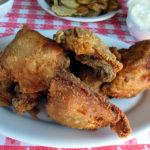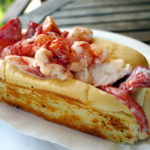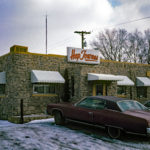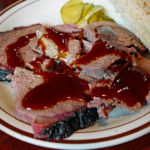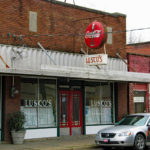Birmingham, Alabama
We venture off the road this month for another in an occasional series of city guides. Our goal is to direct you to restaurants plain or fancy, famous or little known, that provide a memorable taste of America 's good-eating towns. While getting the works in the barber shop of Birmingham's grand old Tutwiler Hotel, we instigated a conversation about where a visitor ought to eat for a true taste of Alabama's "Magic City" (so nicknamed for its astonishing expansion after the Civil War). The relaxing rituals of the tonsorial parlor seem to loosen tongues about any subject, so when we need frank restaurant critiques in an unfamiliar city we often seek out a friendly barber's chair.
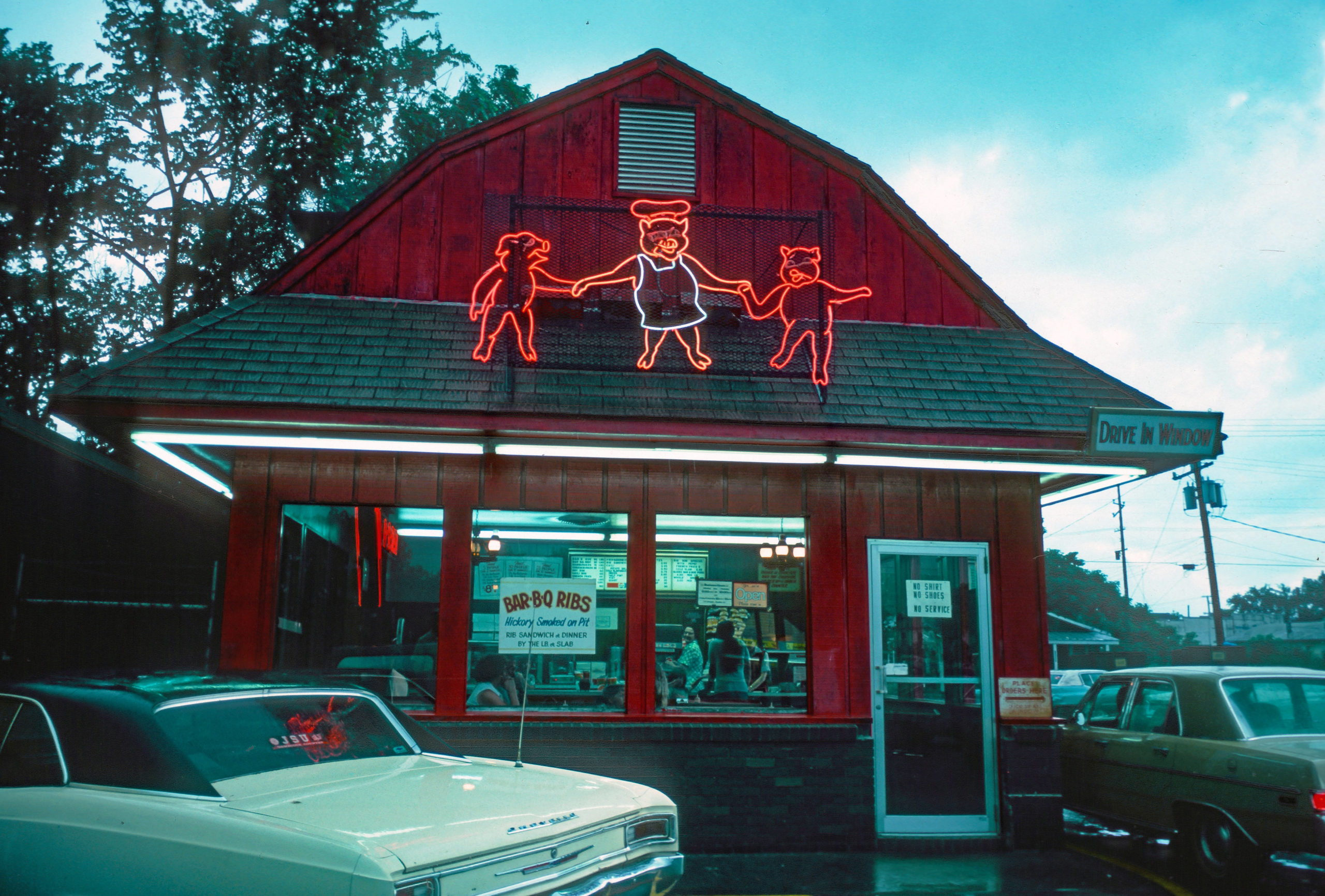
By Jane and Michael Stern
Originally Published 1997 Gourmet Magazine
We venture off the road this month for another in an occasional series of city guides. Our goal is to direct you to restaurants plain or fancy, famous or little known, that provide a memorable taste of America ‘s good-eating towns.
While getting the works in the barber shop of Birmingham’s grand old Tutwiler Hotel, we instigated a conversation about where a visitor ought to eat for a true taste of Alabama’s “Magic City” (so nicknamed for its astonishing expansion after the Civil War). The relaxing rituals of the tonsorial parlor seem to loosen tongues about any subject, so when we need frank restaurant critiques in an unfamiliar city we often seek out a friendly barber’s chair.
The buzz among barbershop epicures was about the city’s newest fashionable dining room on the south side of town, the HOT AND HOT FISH CLUB, situated in a semi subterranean space that used to be a raffish bar known for the graffiti on its walls. Now scrubbed clean and outfitted with handsomely crafted tables and chairs (but with the old octagon-tile floor still intact), it is a convivial place with an exhibition kitchen and about a dozen counter seats for customers who like to watch. Chef Chris Hastings borrowed the odd name from a nineteenth-century eating society to which his great-great-grandfather belonged. It refers to what the bygone gourmands liked to eat—fish served sizzling-hot with zesty condiments.
Bright-flavored seafood still stars. Soft-shelled crab is served with ginger aioli; whole roasted snapper is garnished with green-tomato salsa; Southern bouillabaisse glistens in a fennel-saffron broth. Our meal started with a house Martini made of Ketyl One vodka muddled with hot peppers. Slices of just-baked baguette and a loaf of wild-yeast levain bread arrived soon after. Next came a romaine salad draped with luscious warm fresh anchovies and sprinkled with melt-in-your-mouth crisp-cooked capers. Whole fried okra was vibrant green and still crunchy (“from our garden!” the waitress boasted). Roasted quail was accompanied by polenta and grilled plums, and a slab of moist, bright pink salmon with lemon-butter-chive sauce was presented on a bed of marvelous little potatoes described on the menu as “fresh dug.”
Hot and Hot’s Chris Hastings earned his stripes as a chef in Birmingham’s best known modern restaurant, HIGHLANDS BAR & GRILL, located just a few blocks away. Opened in the early 1980s by native son Frank Stitt III, the Highlands is a debonair bistro decorated with gastronomic posters from decades past, frequented by well-dressed Birminghamians in a cheerful mood. What fun it is to begin an evening at the marble raw bar, where Gulf oysters are opened in a trice and presented on the half shell by Rod Clark (who has won contests for the state’s best shucker) along with Gulf shrimp and marinated crab claws. When we order ordinary apéritifs, gregarious neighbors tsk-tsk those mundane cocktails, recommending instead the house special—watermelon Margaritas—when it’s time for our next round. Inspired by Harry Cipriani’s way with squeezed peaches for Bellinis (which chef Stitt learned first-hand), these pink libations prove sugar-sweet and powerfully intoxicating, that is, profoundly Southern.
The Highland kitchen toys with tradition. Smoked bacon and porcini gravy, a mysterious gloss on the red-eye version made from country ham, is drizzled over grilled swordfish. “We thought Frank was crazy,” a waiter confesses. “Who’d ever have thought bacon would work with fish?” It does more than work: It is a tour de force. So things go at this audacious culinary salon, where baked grits are flavored with fresh thyme and served with wild mushrooms and country ham; sliced pork comes on soft tiles of corn bread with crayfish aioli; and roast duck is sided by matchstick-thin sweet-potato fries. The mantra of modern cookery—fresh—makes routine ingredients new and exciting again. The swordfish is day-boat provender, caught hours before it is cooked; tomatoes, sunny and aromatic, are from Stitt’s garden; eggs are retrieved from chickens on a nearby farm to go, hard-boiled, in a watercress salad.
A few years back, Mr. Stitt opened his second restaurant, BOTTEGA, in an elegant stone villa built in the 1920s to house a ladies’ clothing store. There are two halves to the enterprise, one a breezy café open from midday through the evening for casual fare and drinks, the other a more ambitious dining room open only for dinner. The café has become one of Birmingham’s prime see-and-be-seen places, mobbed after work with short-sleeved sybarites enjoying wine by the glass, boutique beer, andouille sausage pizza, and vegetable frittata.
The restaurant next door is festive, too, its high walls outfitted with handsome walnut panels that were originally fitting-room partitions, the big space alive with voices of people eating, drinking, and making merry. Just inside the front dog/ an aesthetic tone is set by displays of focaccia, just-picked (that morning) tomatoes, and herbed olives, all of which are part of an au courant Mediterranean menu that makes maximum use of local ingredients. Yellow squash is taken from the Bottega garden for a torta garnished with grilled Vidalia onions; regional crayfish add indescribable richness to a risotto studded with scallions and fresh herbs; egg pasta is topped with a slew of fresh vegetables. Dessert sorbets, made from sweet watermelon, cantaloupe, and berries, are full-flavored beyond imagination—sheer essence of fruit.
Birmingham isn’t usually considered a major eating town, but the local produce, seafood from the Gulf, and saucy chefs in the kitchens of Bottega, the Highlands, and Hot and Hot Fish Club make it a rewarding destination for any inquiring appetite.
If it’s a Southern meal you’re after, I will tell you just where to go,” advised a barber-shop tipster as a hot towel was unwound from his face. He had previously proven epicurean credentials by citing the Highlands Bar & Grill as his favorite fine-dining room in town, so we paid close attention when he pointed a finger upward underneath his smock to make a point and announced, “The Farmer’s Market.” Other patrons enthusiastically confirmed his suggestion of a place called NIKI’S WEST in the north end of town across from the Birmingham Food Terminal.
A quaint country green market Niki’s neighborhood is not. Rumbling with trucks serving warehouses where produce is loaded and shipped, it is an unlikely location for anything other than a gear-jammers’ diner. But Niki’s is no diner; in fact, Niki’s does not quite fit any genre of restaurant. It is a low-slung banquet hall with signs in its vestibule warning customers: “No Tank Tops, No Bare Feet, No Rollers on Head,” and, furthermore, “Smoking is not encouraged but accepted.” If you can live with such rules, you enter a cool, commodious space with a nautical/Aegean theme (fish nets, scenic pictures, mounted fish) and a cafeteria line where servers sell food with the enthusiasm of an auctioneer: “Have yourself a nice little seeded roll! …Look at these smooth mashed potatoes…Don’t those beef ribs look big and fine?”
Multigenerational families, blue-collar and white-collar workers, bargain hunters, and big eaters wind through the fast-moving line piling trays with plates and bowls of food. Seafood abounds—baked fish Creole, broiled mackerel, grilled amberjack—and there is always delicious baked Greek chicken, but it’s vegetables that set the appetite awhirl. Vegetables are a preoccupation in this part of the South, where the growing season lasts the better part of a year. We counted more than three dozen of them in Niki’s cornucopian array, including yellow squash casserole, fried green tomatoes, black-eyed peas, and three different kinds of seasoned greens (turnip, collard, and spinach), all guaranteed by one impassioned server to be “Ninety-eight percent fresh, except for some dried peas we use.” Some lovely items from the market such as sliced tomatoes, raw vegetables vinaigrette, and baby lima beans are austere enough to please any dieter, but most of Niki’s produce is prepared according to the more voluptuous Southern café tradition. Broccoli is mixed with cheese and rice in a crazy-rich mélange; tomatoes are stewed with sugar and shreds of torn white bread until they become as sweet as cobbler; bright-orange sweet potatoes are infused with sugar; crunchy-fresh okra is sheathed in a deep-fried crust. Among the dessert selection, we were less impressed with Niki’s cream pies than with its banana pudding, a baby-food bowl of custard and softened vanilla wafers. Curiously, a take-out menu lists the pudding, along with apple and peach cobbler, as a vegetable!
Like Niki’s West, many of Birmingham’s enduring dining rooms are Greek-run. Though none serve strictly ethnic food, the heritage is apparent in such fare as the Gulf snapper broiled in olive oil and lemon juice that leads the menu at CONNIE KANAKIS’ CAFE, a city institution that relocated to a pleasant mauve and teal setting out at the Colonnade mall. SARVAC’S cafeteria, still downtown, has a sign declaring itself “Home of the Giant Chicken,” which turns out to be half a bird, expertly baked with a distinctively Greek zest to its crisp skin. At a marvelous place called JOHN’S, you can start a meal with a plate of black olives, feta cheese, and Salonika peppers, then enjoy elegant red snapper in lemon butter and olive oil, spangled with chopped scallions, oregano, and parsley. A city fixture since 1944, John’s is a refined luncheonette with metallic foil wallpaper, gold chandeliers, and flatware that comes wrapped in linen napkins. Seafood has always been its forte, from raw oysters and West Indies salad (marinated Gulf crab meat) to a bewitching smoky gumbo that makes a delicious meal with crisp corn sticks on the side. John’s also happens to be the original source of a weird way with coleslaw now practiced by many local restaurants: You get a plate of finely shredded plain raw cabbage onto which you squirt secret sauce, a beguiling spiced up variant of sweet Russian dressing.
Bottega
Connie Kanakis’ Cafe (permanently closed)
3423 Colonnade Parkway
Birmingham, Alabama
Dreamland
Highlands Bar & Grill
Hot and Hot Fish Club
John’s
Johnny Ray’s
Ollie’s Barbecue (permanently closed)
515 University Boulevard
Birmingham, Alabama
Sarvac’s (permanently closed)
401 18th Street South
Birmingham, Alabama
Discuss
What do you think of Birmingham, Alabama?
Related Articles
Stroud’s
By Jane and Michael Stern Originally Published 1995 Gourmet Magazine Chicken...
The Lobster Roll Honor Roll
Maine is the only state in America that features a picture of cooked food on its license...
Meat-And-Three
A few years back, country singer Ray Stevens invited a New York friend to join him at one of...
Top 12 favorite Ice Cream Scoops
WITH THE EXCEPTION of the hot dog bun, there has never been an edible invention as...
Top 5 BBQ Restaurants | Western Kentucky
Get yourself to Western Kentucky for great BBQ I see the food shows on TV where...
Best restaurants in Greenwood, MS | Hot Licks Delta Style
Ever since we first ate margarine-sauced pompano at Lusco’s, in Greenwood,...

